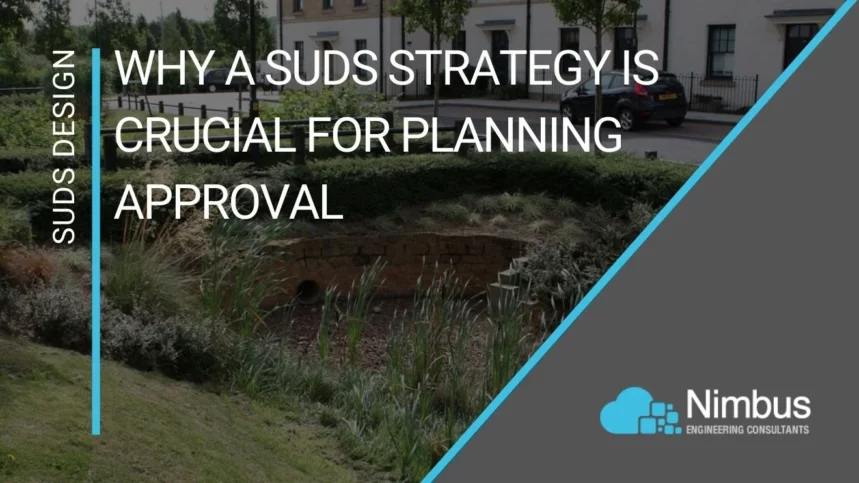Conducting a SuDS report on your development is often stipulated as part of the planning approval process, but what are the other key reasons why having a SuDS strategy is crucial for planning approval?
A Sustainable Urban Drainage Strategy (SuDS) is the consideration of how surface water drainage and flooding will be managed at a new development site. Sustainable drainage systems aim to mimic natural drainage while also reducing flooding by catching or storing it where it falls.
The reason why SuDS are so important as part of planning is that local authorities and the UK Environment Agency are very concerned with the rise of local and national flooding, and the impact that can have on people and their property.
As more sites across the UK incorporate SuDS into their design and construction, we can collectively reduce the pressure on traditional piped drainage and decrease the risk of flash flooding.
In this article, we will explore when SuDS design is expected as part of new developments, as well as other key reasons why SuDS is crucial for planning approval.
When is a SuDS Strategy Stipulated in Planning Applications?
A SuDS strategy is required if a development meets the following conditions:
- A development with more than 10 dwellings
- Commercial Floorspace over 1000m2
- Development is located within an area at risk of flooding, or within an area identified as having critical drainage problems
But what about developments that don’t meet these stipulations? Is a SuDS or Surface Water Drainage Strategy a condition of their planning permission?
Well, it is becoming increasingly important to demonstrate to the Local Planning Authority and the Lead Local Flood Authority that surface water drainage has been considered in most new developments.
A sustainable surface water strategy benefits the environment, reduces the risk of water pollution and flood damage, and also contributes to improving wildlife and biodiversity in urban landscapes.
What Are the Other Reasons A Suds Strategy Will Be Important as Part of Planning?
The Site Development Has A High Water Table or Clay Based on Soil
Although not always deemed an area with a high risk of flooding, regions of the UK where there is a high water table or clay-based soil can be at risk of flooding.
Heavy clay-based soil impacts the soil infiltration rate, meaning water takes longer to soak away. This can often mean certain elements used in a standard SuDS strategy are no longer effective, so more work is needed to overcome any risk of flooding. In such a scenario it might be an added thing you need to sort out, including getting your development connected to the storm drain.
Your Specific Lead Local Flood Authority (LLFA) Requires One
A detailed drainage design is often required due to local planning policy as well as the view of the specific Lead Local Flood Authority (LLFA). They can determine drainage as a critical issue in your area, and make a SuDS report a requirement of planning. The level of detail required can vary for each LLFA, some are happy with a basic SuDS report that provides an outline of SuDS strategy in writing, supported by hydraulic calculations and a desktop infiltration study. Some LLFAs will also request a full drainage strategy to include an outline foul drainage strategy also.
Whereas, some LLFAs also request detailed drainage layouts to include pipe sizes, cover and invert levels of all manholes and SuDS, all provided in proposed layouts and include connections to existing systems. When we have been instructed on these, we liaise with the client and architect to ensure that the solutions proposed can be developed through to the planning condition discharge and construction stage, without repeating work or carrying out abortive work, which ultimately means the client does not end up paying for the same service twice.
Due to our many years of experience in this field, nationwide, we are aware of which local authorities request SuDS reports for planning applications, from minor extensions to larger developments, therefore we can inform you of this, as well as the level of detail required by each.
On occasions, we are told by the clients that they have had a cheaper quote elsewhere, but the clients find that their appointed consultant is not aware of the requirements, leading to the planning application being refused or the appointed consultant charging extra to meet the specific requirements of the LLFA.
SUDS Strategy
A SuDS strategy is often a crucial element of any new development, even for minor extensions, but there is no need to panic if planning stipulations are placed on your development. Planning applications are mostly rejected due to SuDS designs not being taken into account, but hey, you are already reading his article and aware of it now.
In many instances, SuDS can be implemented into a development easily and at a lower cost than traditional drainage systems, especially when it is considered in the early stages of a development project.
Choose Nimbus for your SuDS Design
As Civil Engineers and not just Environmental consultants, we can give you early-stage advice for sustainable drainage designs to practically integrate into your development, allowing you to work around any constraints or risks, in a natural and ecological way.
Nimbus can provide you with SuDS reports and assessments that will give you a sustainable drainage strategy, with the required level of detail, to minimise surface water run-off from your proposed development, helping you achieve planning application approval. Talk to us today!


